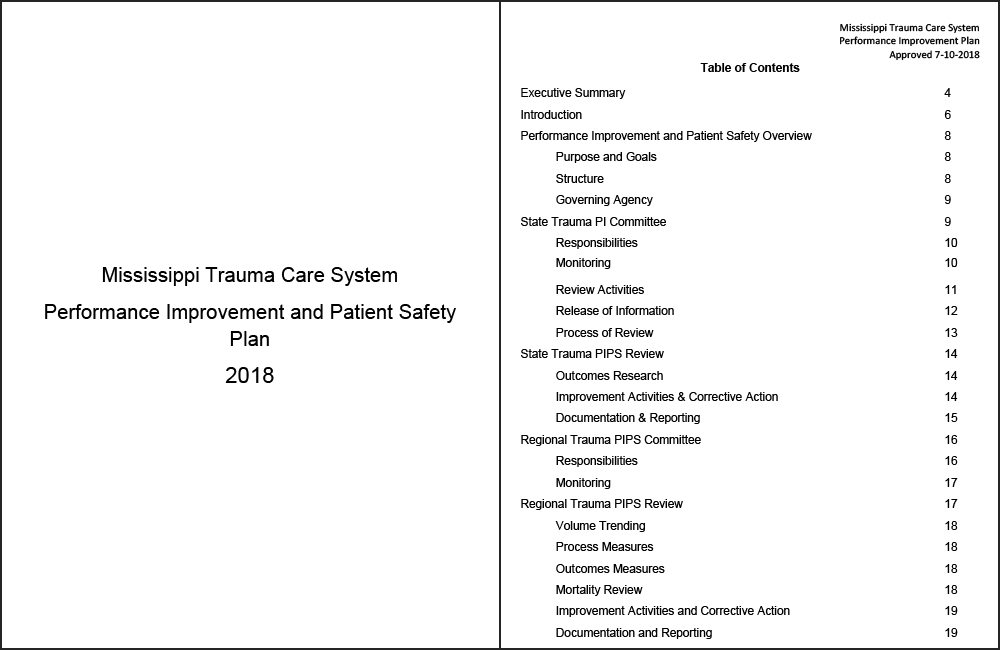
Mississippi Trauma Care System; PI and Patient Safety Plan
INTRODUCTION
A systems approach to trauma care provides the best means to protect the public from premature death and prolonged disability. Trauma systems reduce death and disability by identifying causes of injury and promoting activities to prevent injury from occurring, and by assuring that the resources required for optimal care are available. A major goal of trauma care systems is to provide care that is efficacious, safe, and cost-effective.
Performance Improvement and Patient Safety (PIPS) in an organized trauma system consists of multiple layers of continuous monitoring and evaluation of care to identify opportunities for improvement. This progressive cycle of evaluation extends from the performance improvement (PI) programs of hospitals and emergency medical services (EMS) agencies to review committees established at the state and regional levels, and evaluation programs within the MSDH including the Mississippi Trauma Registry (MTR).
This model emphasizes a continuous, multidisciplinary, multi-layered effort to monitor, measure, assess, and improve the process and outcomes of trauma care. Regardless of the hospital, service, or region, care processes and the clinical management of trauma patients must be evaluated using an established methodology with pre-defined measures based on national or state recognized standards. This review should include comparison and benchmarking of services, hospitals, and regions with state or national data obtained through trauma registries, mortality studies, and outcomes-related research.
This plan was developed to assist and guide trauma committees responsible for PIPS within agencies, institutions, or regional and state systems. Each section provides PIPS advice for each level of responsibility and is written to stand separately as a guide for that level. As a result, there is some duplication of information throughout the manual. The appendices offer explicit examples and language for PIPS activities which may be adapted. Adhering to the processes described will provide a foundation for a successful trauma center and system PIPS program but is not considered a replacement for a consensus process under the direction of a Trauma Medical Director and Trauma Program Manager. Mississippi Trauma Care System
Other resources to consult as efforts to implement trauma PI statewide evolve include:
- “PIPS Reference Manual” (ACS 2002)
- “Resources for Optimal Care of the Injured Patient” (ACS 2014)
- Advanced Trauma Life Support Manual (ATLS)
- Evidenced based practice guidelines or reviews
- American College of Surgeons
- Eastern Association for the Surgery of Trauma (EAST)
- US Department to Health and Human Services
- Agency for Healthcare Research and Quality (Evidenced-based Practice Program)
- National Guideline Clearinghouse
Together with this plan, the advice of those resources should result in activities necessary for improving trauma care locally, regionally, and state-wide. Seeking the regular advice of professionals with expertise in trauma PI is strongly recommended to assure that PIPS processes meet contemporary theory and comply with State law governing protection of clinical care review.
It is acknowledged that modifications and adaptations of this model will occur to allow for the unique characteristics of trauma care provision in each MS Trauma Care Region.
Specifications
- Last Updated: 2018
- Author(s): Mississippi Trauma Care System
- Category: Performance Improvement
- Tags: 2018, English, Mississippi Trauma Care System
PDF Documents
Please login to access file downloads.
